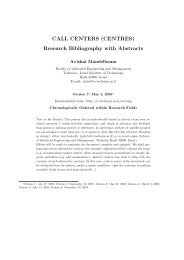Variations on the Shapley value
Variations on the Shapley value
Variations on the Shapley value
You also want an ePaper? Increase the reach of your titles
YUMPU automatically turns print PDFs into web optimized ePapers that Google loves.
(1) Gilboa and M<strong>on</strong>derer (1991) discussed quasi<strong>value</strong>s defined <strong>on</strong> subspaces of<br />
games. They gave necessary and sufficient c<strong>on</strong>diti<strong>on</strong>s that ensure that such<br />
quasi<strong>value</strong>s can be extended to quasi<strong>value</strong>s <strong>on</strong> G.<br />
(2) M<strong>on</strong>derer (1992) used <strong>the</strong> c<strong>on</strong>cept of quasi<strong>value</strong> in order to provide a game-<br />
<strong>the</strong>oretic approach to <strong>the</strong> stochastic choice problem. He used Theorem 3<br />
to c<strong>on</strong>firm a c<strong>on</strong>jecture of Block and Marschak (1960), which had already<br />
been proved before by Falmagne (1978). The relati<strong>on</strong>ship between <strong>the</strong> sto-<br />
chastic choice problem and quasi<strong>value</strong>s was fur<strong>the</strong>r analyzed by Gilboa and<br />
M<strong>on</strong>derer (1992).<br />
5. Weighted Values. Weighted <strong>value</strong>s comprise a special class of quasi<strong>value</strong>s,<br />
and more specifically of path <strong>value</strong>s. We describe two forms of such <strong>value</strong>s. Both<br />
were introduced by <strong>Shapley</strong> (1953a,b), al<strong>on</strong>gside <strong>the</strong> standard <strong>Shapley</strong> <strong>value</strong>, and<br />
were axiomatized by Kalai and Samet (1987).<br />
Let ω ∈ R N ++ (that is, ωi > 0 for every i ∈ N). Recall that a unanimity game<br />
uS, for S ∈ C0, is defined by uS(T ) = 1 for T ⊇ S and uS(T ) = 0 o<strong>the</strong>rwise, and<br />
that <strong>the</strong> set of unanimity games, for all S ∈ C0 is a basis for <strong>the</strong> linear space G of<br />
games. The positively weighted <strong>value</strong> ϕ ω (which is called <strong>the</strong> ω-<strong>value</strong>) is <strong>the</strong> unique<br />
linear operator satisfying<br />
ϕ ω uS(i) =<br />
ωi<br />
ω(S) , for i ∈ S<br />
0, for i ∈ S<br />
for each unanimity game uS. If ωi = 1<br />
n for every i ∈ N, <strong>the</strong>n ϕω is <strong>the</strong> <strong>Shapley</strong><br />
<strong>value</strong>. Owen (1972) has shown that positively weighted <strong>value</strong>s are path <strong>value</strong>s, <strong>the</strong><br />
path α being defined by<br />
(5.1) αi(t) = t ωi for every t ∈ [0, 1].<br />
11
















